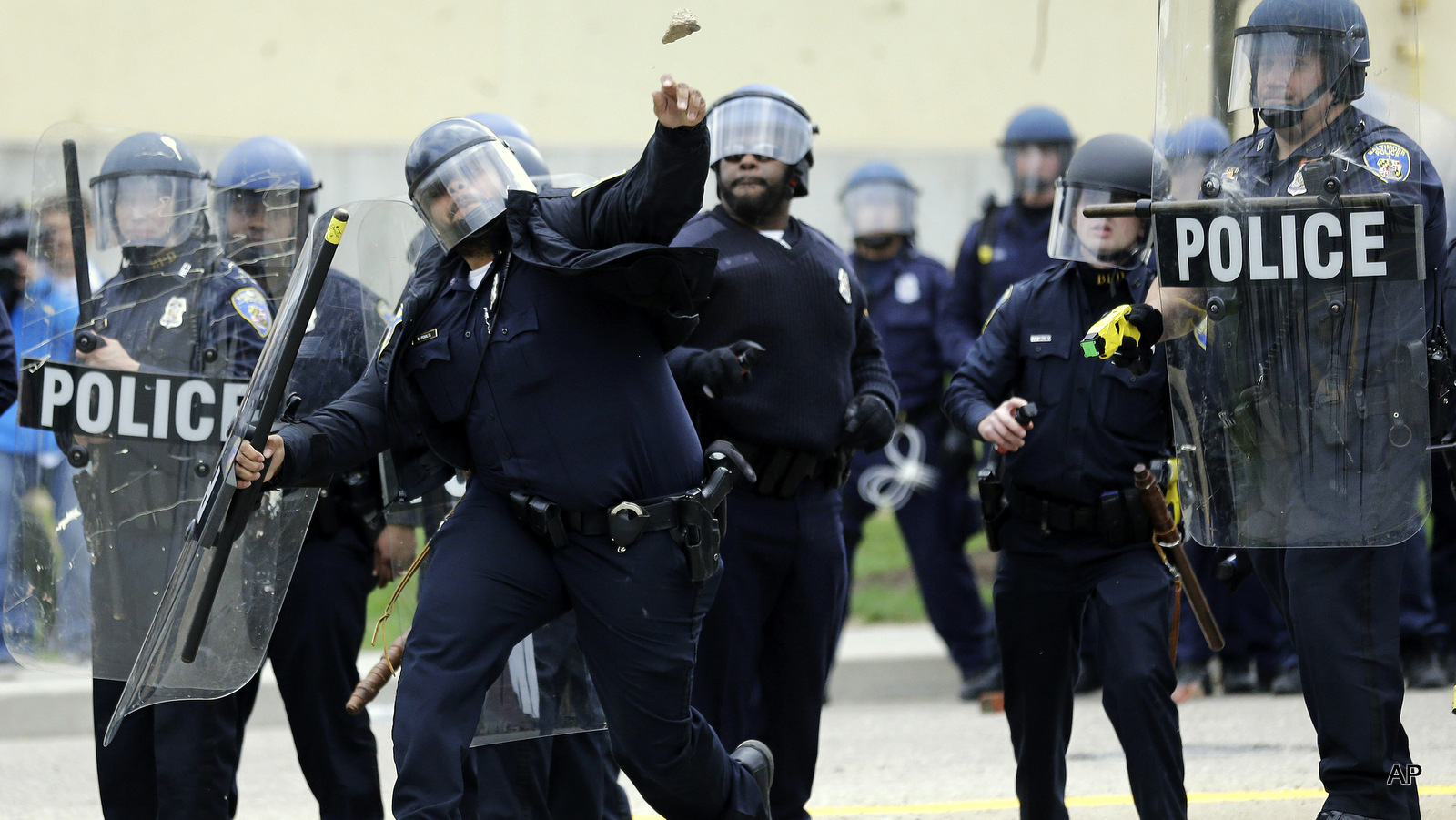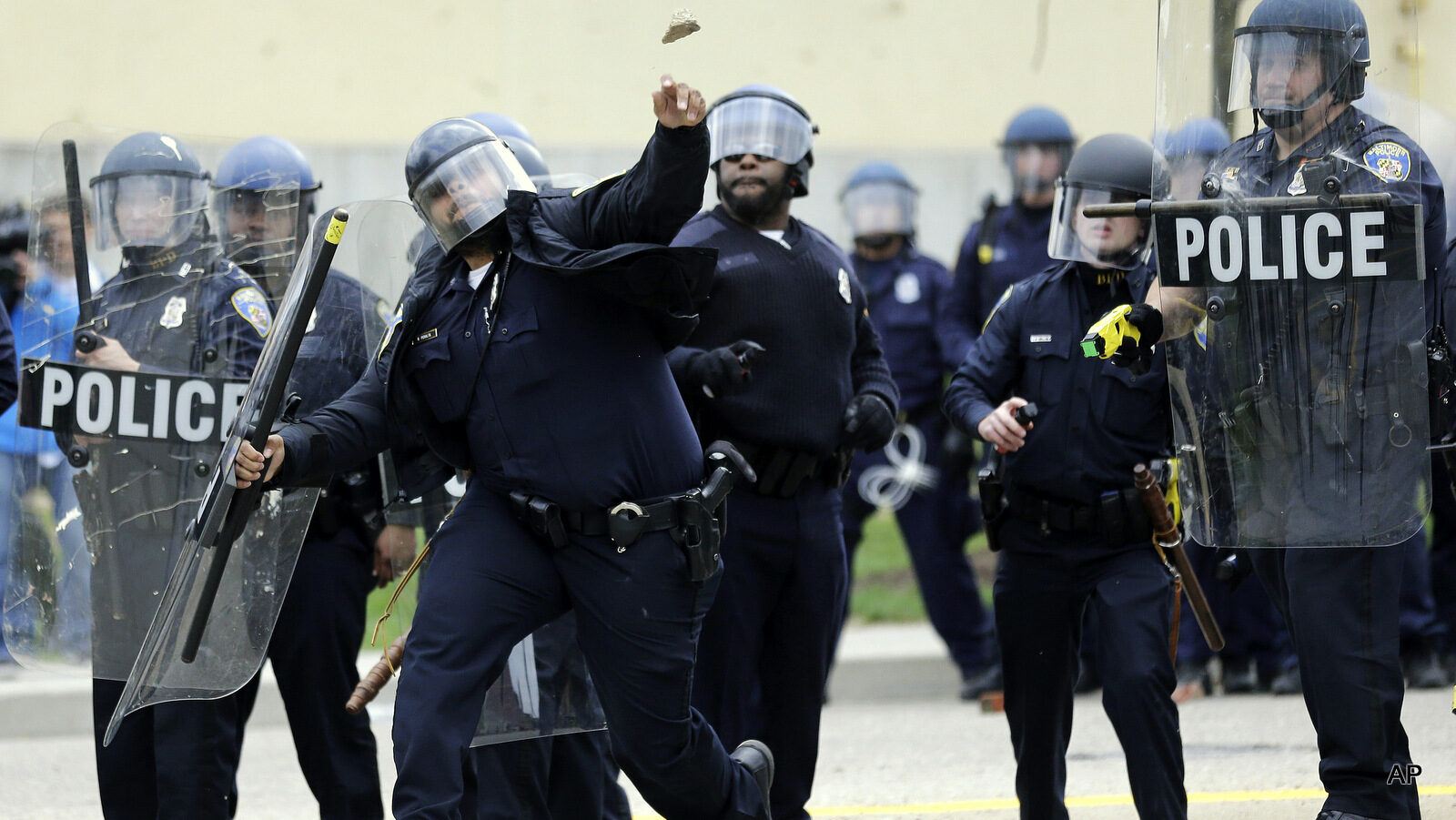 A police officer throws an object at protestors, Monday, April 27, 2015, following the funeral of Freddie Gray in Baltimore. Gray died from spinal injuries about a week after he was arrested and transported in a Baltimore Police Department van.
A police officer throws an object at protestors, Monday, April 27, 2015, following the funeral of Freddie Gray in Baltimore. Gray died from spinal injuries about a week after he was arrested and transported in a Baltimore Police Department van.
When one looks upon the recent bout of unrest in Baltimore, and, prior to that, in Ferguson, Missouri, one can’t help but think of the metaphor of the canary in the coalmine. For those unfamiliar with the expression, it dates back to the days when mines lacked detectors which could sense the presence of carbon monoxide gas. Instead, miners took the proverbial canary, or some other unfortunate creature, down into the mines with them in the theory that if they ever found the animal dead, that was signal that the odorless, toxic vapor had risen to levels dangerous to humans.
The catch, of course, was that the animal died in the process. Urban canaries, on the other hand, end up burned and looted, adding additional blight to areas that can usually ill afford it. Unfortunately, the canary’s sacrifice only means something if one of the miners down in the cave with it actually noticed and had power to do something about it.
With parts of Baltimore in flames less than a year after Ferguson was wracked by unrest, one would think we here in the United States would begin to understand what’s going on. And yet that doesn’t seem to be the case.
This is partly because recent events in Baltimore seem so much like what has come before — a black man is apprehended by police for seemingly no reason, and, inexplicably, ends up dead as a result of the encounter. In this case it was Freddie Gray, who mysteriously suffered a fatal spinal cord injury while riding with Baltimore’s finest in a paddy wagon to the local cop shop.
We don’t have smoking-gun video evidence of wrongdoing as in the equally horrid recent cases of Eric Garner and Walter Scott, who was shot in the back by a South Carolina cop now charged with murder. But there seems little doubt that the Baltimore Police Department, which has a record of employing shady, violence-prone officers, acted either with extraordinary incompetence or with malice aforethought. An investigation, as they say, is ongoing.
Patterns of violence
On the one hand, events in Baltimore seem to be part of an unending string of incidents that highlight the tensions between black Americans and those in blue. What’s unfolding in Baltimore is perhaps getting more attention due to the recent spotlight on such encounters and the use of social media to spread word about them, but it’s otherwise unremarkable due to the sad ubiquity of such occurrences in this country. The likely outcome, in turn, is incremental reform of police forces in some areas, perhaps some additional civilian oversight of what the cops do on a daily basis, and a lot pontificating by talking heads and politicians.
If one looks deeper, though, there seems to be something going on here that warrants more than America’s usual depressing response to racially-tinged police shootings. For one, they come after a decade and a half of sustained losses by poor and middle-class Americans that’s left them increasingly pressured by an economic system that has no place for them. Not only has inequality reached Gilded Age heights, but since 2000 the middle class has been shrinking as more and more middle-class Americans fall from it instead of climbing out. Depressingly, current estimates suggest that one-third of the people born into middle-class households — defined as those between the 30th and 70th percentiles of income — will fall out of it as adults.
Thus, vast numbers of Americans have effectively found the ladder of social mobility transformed into a chute of proletarianization, and only by the very hardest efforts are the remaining members of this class of Americans staying afloat. If this is what’s happening to middle-class Americans, then just imagine what is happening in places like Baltimore, where available data shows one in three kids grows up in poverty. What’s more, this poverty is also highly concentrated. Some areas of Baltimore, for instance, see 97 percent of children eligible for free or reduced school lunches. Couple that grinding poverty and lack of a true chance of upward mobility that is the norm in contemporary America with the unstinting horror of the militarized drug war, and what we get are concentrated pits of socio-economic oppression that look more like Afghanistan than America.
Racism is the comforting answer
That riots of the type we’ve seen in Ferguson and Baltimore should result comes as no surprise. After all, under similar conditions other places have similarly erupted both here in America and abroad. During the 1960s, for instance, far worse urban riots wracked America’s cities for what were essentially the same reasons, while discontent by oppressed masses in places like Tunisia and Egypt more recently bubbled over into uprisings that sought democratic reform in those two countries.
Unfortunately, the recent events in Baltimore and Ferguson are different from those instances in at least one important respect: Change, both in 1960s America and the Middle East at the height of the Arab Spring, seemed possible.
For the citizens of Baltimore and Ferguson who erupted in rage, however, what hope of change for the better do they realistically have? The city’s mayor is a black woman. Less than half of the city’s police force is white. The president, although hobbled by a right-wing Congress, is also black. All this suggests that what this current bout of unrest is about is not so much race, although that is important, but class, economic immobility, and, as result, the interlocking system of oligarchical wealth that actually runs this country for its own benefit. An oligarchy, too, which has increasingly rigged the game since the Reagan era so as to give themselves every advantage and which has used tools of state oppression to box in and control those who aren’t party to running the system.
Little wonder, then, that so much emphasis is placed on race and racism as opposed to poverty, inequality and the way in which our socio-political system frequently leaves whole communities out to dry. After all, such a discourse makes both the conservative right and their opponents on the liberal left exceedingly uncomfortable. A race-orientated explanation of events in Ferguson and Baltimore, on the other hand, has an easy-to-follow narrative featuring “good guys” and “bad guys” for both sides — all that differs is who plays the villain. The solution in this setup is also relatively straightforward. For liberals, the answer is to replace the racist cops. For conservatives, their answer is to go after bad actors in the community, which is irresponsible and lacking in character on the whole.
Civilization isn’t a free lunch
Left unmentioned is the system of oppression, created by America’s institutionalized left and right, that has created this nightmare to begin with and which, as the data points to above, is beginning to encompass more and more of the country. The hard fact is that the social problems caused by mass poverty simply do not go away because we deign to take away the funding that goes to alleviating them. They also don’t go away if we shut our eyes to them by forbidding that they even be studied, as many conservatives increasingly want to do. The poor and the disenfranchised may be invisible, but they don’t disappear, and acting as if they do merely makes the problem worse and more expensive over time. There’s no free lunch, and we pay, one way or the other, for the way our country leaves the poor out on a limb and far from a leafy gated community.
But, of course, there is a nice way to pay and a not-so-nice way. The nice way is through redistribution that alleviates poverty directly through programs like social security and foods stamps, or indirectly via education spending. The not-so-nice way can be seen in Baltimore, where angry mobs of disenfranchised young men took to the streets and burned down a drugstore. Paying to contain that violence and to police the permanent and growing underclass we’ve created is expensive. Funding police, prison and mass incarceration, it turns out, is how America actually pays for the domestic problems it has ignored and left to fester. For decades, we’ve chosen to pay in the not-so-nice way, and the consequences of that are catching up with us.
That this is a terrible, foolish solution which is both counterproductive and exceedingly dangerous should be obvious. After all, the flames that consumed parts of Baltimore aren’t so far away from the geographic bolt holes that the rich have built for themselves. How soon before some of those angry young men — men who, because of their circumstances, have life expectancies 20 years below that of folks who live just six miles away — tire of burning and looting their own neighborhoods and turn, instead, to more lucrative zip codes and addresses? How soon before they tire of listening to calls for peace from within their own community when, from what they can tell, peace has gotten them nothing, just someone who looks like them in the White House who offers nothing but empty platitudes?
What then, indeed. We’ve been down this road before, and it isn’t pretty. Having a civilization worth living in takes constant investments of time, resources and empathy for those unlike ourselves. Take that away, and the legitimacy of authority that is what really keeps people from burning down neighborhoods will tatter and fray. Once that begins, our fellow citizens begin to look like foreigners, possibly even enemies – and we all know what happens to America’s enemies. What happens when we finally reach that point is anyone’s guess, but the fact that America’s police look like an occupying army, the country has the world’s highest imprisonment rate, torture is accepted, and our government routinely spies on us should be sign where this dark road will lead.


